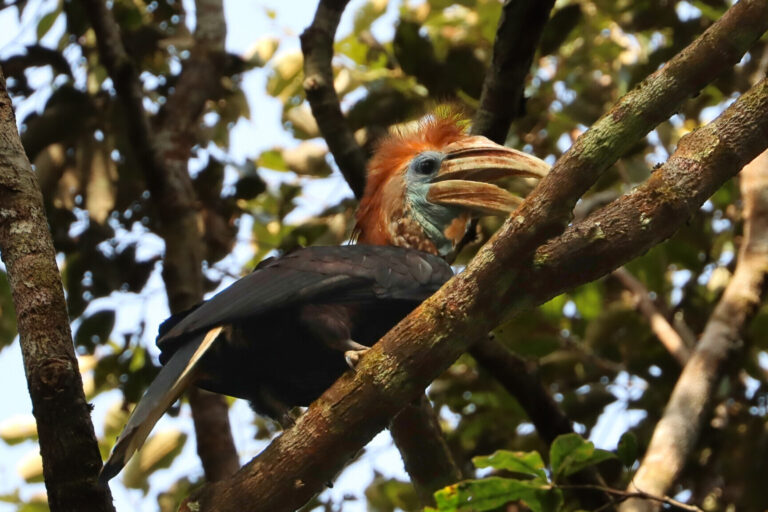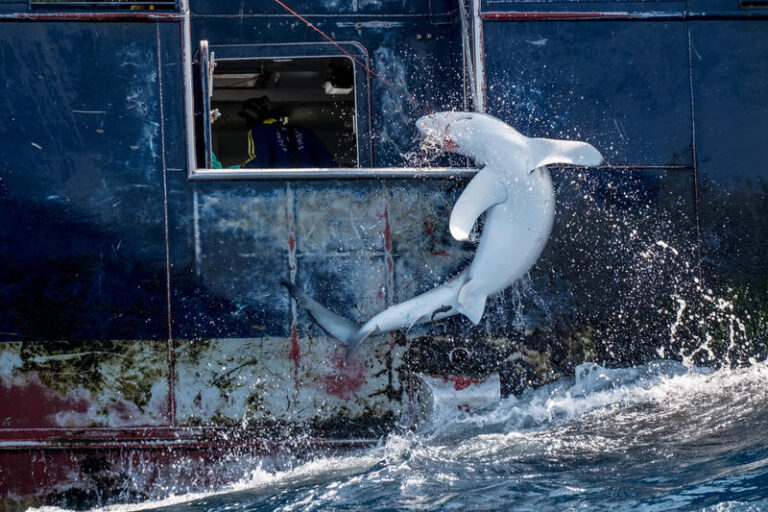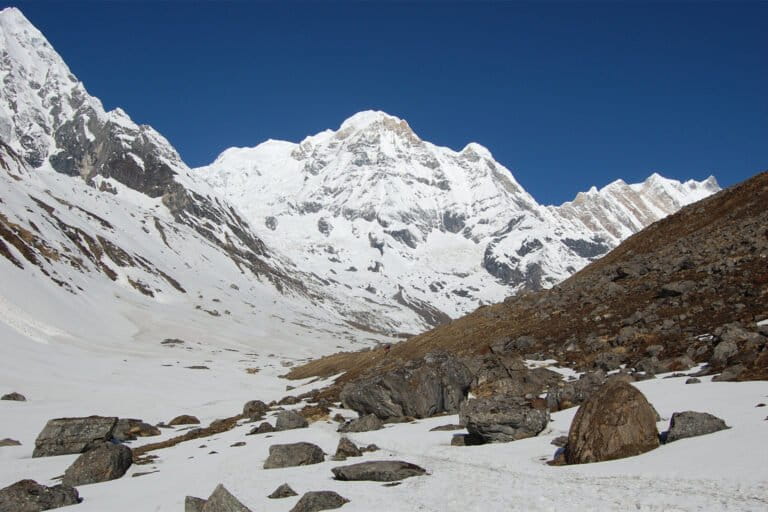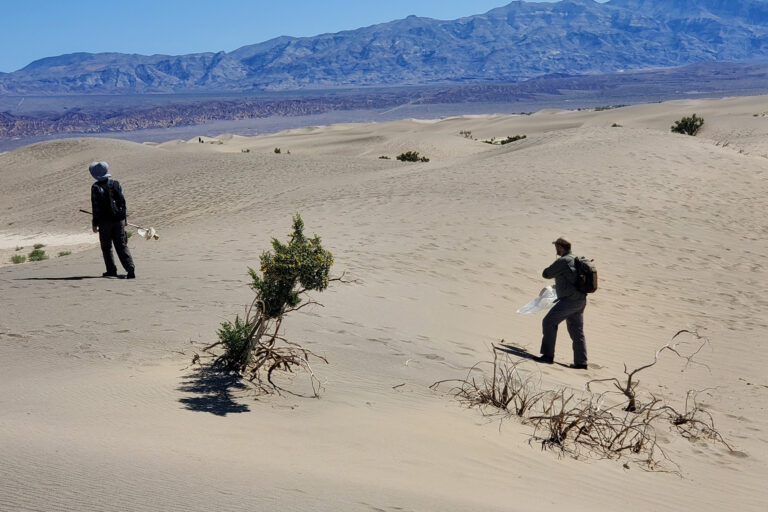- Cameroon currently has more than 250 rescued chimpanzees living in three chimp wildlife sanctuaries. Attempts to find forests into which to release them — safe from the bushmeat and pet trade, and not already occupied by other chimpanzee populations — have failed so far.
- The intensification of logging, mining and agribusiness, plus new roads into remote areas, along with a growing rural human population, are putting intense pressure on un-conserved forests as well as protected lands.
- Unless habitat loss, poaching and trafficking are controlled in Cameroon, reintroduction of captive chimpanzees may not be achievable. Some conservationists argue, however, that reintroduction of captive animals is needed to enhance genetic resilience in wild populations.
- If current rates of decline are not curbed, primatologists estimate that chimpanzees could be gone from Cameroon’s forests within 15 to 20 years.
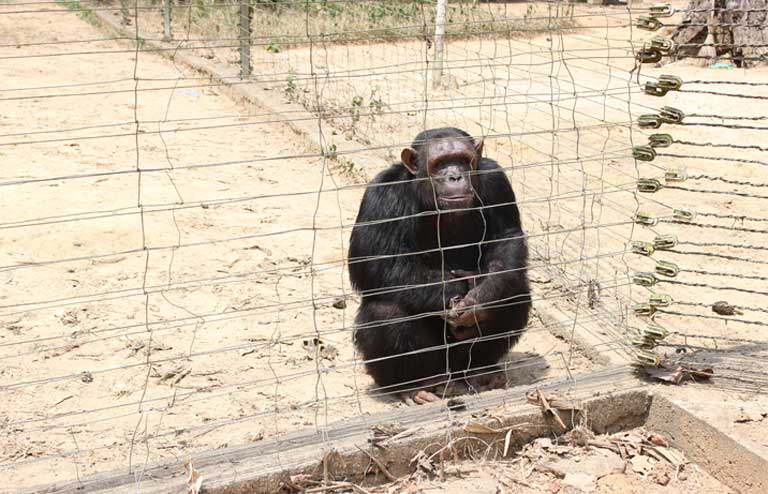
YAOUNDE, CAMEROON — Two male chimps, Avi and Max, take turns inside an electric-fenced compound where eight Central chimpanzees are housed at the Mefou Primate Sanctuary not far from Cameroon’s capital. The broad-chested dominant males aren’t allowed in the enclosure together because keepers fear their rivalry could degenerate into vicious fighting and endanger the entire Pan troglodytes troglodytes community.
Avi and Max are survivors of a brutal bushmeat and pet trade that seriously threatens the Central African nation’s great apes and often leaves infants orphaned. The two males have lived at the sanctuary almost since it was created in 2000.
After the country’s first attempt to release them failed in 2015, it now seems that life in captivity might be their ultimate destiny. Hundreds of other captive chimpanzees face the same fate inside Cameroon’s three ape sanctuaries.
While life inside the sanctuaries is a great deal safer than that in the forest — with chimps well-fed and receiving round-the-clock medical care — some primatologists and animal defenders say the great apes and other primates belong back in the wild.
“Chimpanzees don’t belong in any form of captivity,” contends Sheri Speede, founder and director of In Defense of Animals-Africa (IDA-Africa), which runs the Sanaga-Yong Chimpanzee Rescue Center in Cameroon’s eastern region. “They are better off living free in protected forests, where they can have normal family groups and natural demographics.”
The problem: where to create new protected areas in Cameroon, a nation with rapidly expanding agribusiness and extraction industries, plus a fast growing rural population — all of which are encroaching on un-conserved forests and are a recipe for habitat loss, great ape trafficking and the bushmeat trade.

Not a single site left
A little more than a decade ago, several non-governmental organizations, including IDA-Africa, the Pandrillus Foundation, and Ape Action Africa, along with the Ministry of Forestry and Wildlife, began discussing possibilities for Cameroon’s first chimpanzee reintroduction attempt. Those talks moved ahead slowly.
Eventually, the NGOs — jointly known as the Cameroon Chimpanzee Reintroduction Group (CCRG) — commissioned a study running from 2012 to 2015 to find a suitable forest site into which to release captive chimpanzees.
Switzerland-based Cameroonian researcher Lawrence Baye led the survey. He and his team combed four forests, looking for existing or historical chimp populations, talking to locals, observing current human activities and learning about planned land uses.
“The goal of the three-year-study was to identify a large area of intact habitat forest that was under-protected and depleted of chimpanzees, which could serve as a reintroduction site for the subspecies Pan troglodytes troglodytes,” says Speede.
“We based our search on criteria pertaining to the quality of the habitat, importance from a conservation perspective, use by existing wildlife populations, presence of natural boundaries, and use by human populations locally.”
But the three-year search proved futile — no forests were seen as safe for the chimpanzees, and the reintroduction effort has now been temporality called off.
“The human populations in proximity to the forests were too dense and depended on ongoing extractive and agricultural activities in the forests; planned development projects near the forests promised to bring an unavoidable influx of people in the future; and largescale commercial enterprises, such as logging or mining, were already operating or were slated to begin operations in the forests,” Speede explains.
“The difficulty with reintroduction is that the good, [well-protected] chimpanzee habitats… already have chimpanzees living there,” explains Pandrillus founder Liza Gadsby. And “those [forests] with low populations that could absorb more animals have low populations for a reason — generally poaching.”
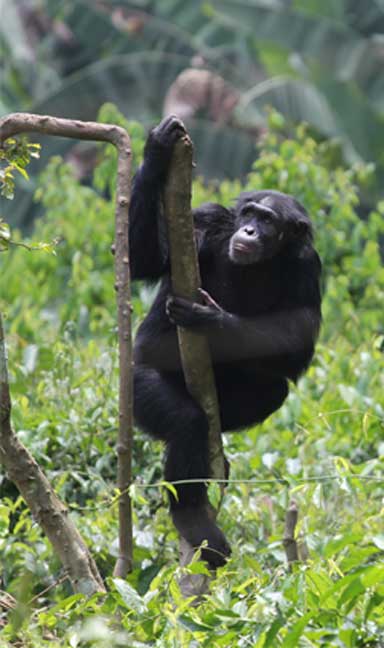
Finding sanctuary
Speede has been at the forefront of Cameroon’s effort to release its captive chimpanzees. A doctor of veterinary medicine, she has spent the better part of her life, including 13 years of fulltime residence in Cameroon from 1998 t0 2011, trying to conserve critically endangered great apes.
A major part of her work is offering refuge to the orphaned primates that manage to escape slaughter in the wild. Working with a team that includes local caregivers, Speede currently houses, feeds and medically cares for more than 70 rescued chimps at the Sanaga-Yong Chimpanzee Rescue Center, a two-kilometer-square “tract of lush habitat” within the Mbargue Forest in eastern Cameroon.
Sanctuaries like this one are essential for dealing with the rising number of rescued primates orphaned in Cameroon each year. These facilities provide a safe haven for young chimps after family groups are shattered by hunters feeding a national appetite for bushmeat, as well as an international demand for pets.
Great apes defenders estimate that Cameroon now has more than 250 chimpanzees trapped behind electric fences in its three wildlife sanctuaries — many of these animals, experts say, could be released to the wild, if they but had a place to go.
The largest population is confined behind tall wire fences that cut through densely packed undergrowth in Mefou Natioal Park — home to Avis, Max and others for more than a decade. Run by Ape Action Africa, the Mefou Primate Sanctuary houses 110 chimps in three enclosures, out of a total of 350 captive primates.
Pandrillus, which runs the Limbe Wildlife Center at the foot of Mount Cameroon, says it is presently caring for 55 chimps at its facility. At the time of rescue, most of these great apes were stranded, malnourished, sick and frightened infants.
Many more of Cameroon’s chimps are caged in private homes as pets and are unaccounted for, notes James Jeta, head of education at Ape Action Africa.
“Dignity and joy”
Cazza, a member of the Mefou sanctuary chimp community, was six months old when rescued from “inside a cardboard box, strapped to the back of a wildlife trafficker’s motorbike.” Likely her mother was killed and harvested as bushmeat. When Cazza was brought to the Mefou sanctuary, the animal was “frightened,” dehydrated and needed lice treatment, according to her profile written up by the Ape Action Africa staff.
“Other [chimps] languished years, sometimes decades, on chains or in tiny cages before we could change their lives,” notes IDA-Africa on its website, referring to the animals in its care.
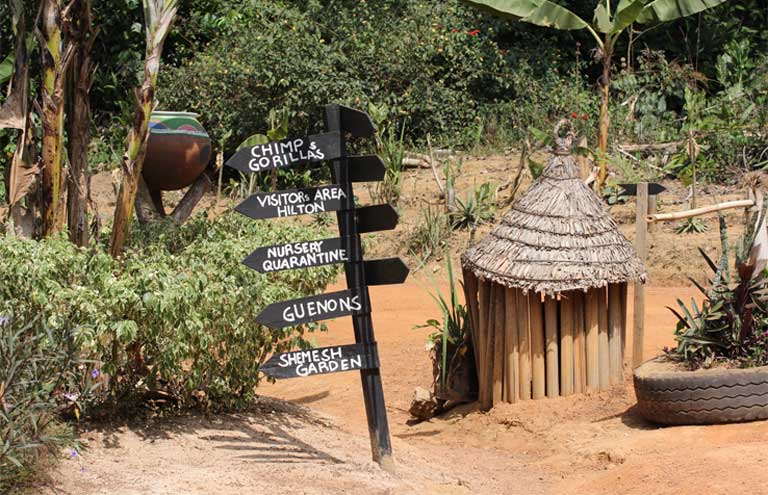
“Their personal histories are all compelling but not unique,” Pandrillus reports on its website, adding that great ape “atrocities continue to play out daily across Africa in the 22 habitat countries where chimpanzees still survive, despite strict laws against hunting, legally protected habitat areas, conservation NGO input, and international treaties against trade.”
Through its work, IDA-Africa says it is offering orphaned chimps “a second chance to live with dignity and joy,” shielded from the combined impacts of poaching, the bushmeat trade and habitat destruction.
In spite of the safe haven that sanctuaries now offer orphaned chimps — some of which were rescued just “hours from death” — keeping the animals behind electrified fences is not anyone’s idea of an ideal solution to the problem, says Jeta of Ape Action Africa.
Africa’s dwindling wild chimpanzees
After the failure of finding a forest in which to safely release captive great apes, Speede says she and her colleagues are focused now on preventing further habitat destruction in Cameroon and tackling the other root causes that pluck wild chimps out of the forest:
“The primary threats to chimpanzees are habitat destruction, hunting and disease,” says Save the Chimps, an NGO: “The increasing human population is encroaching ever deeper into even protected areas of chimpanzee habitat, and large scale logging is now a major threat to the forest primates of Africa.” In addition “there is now a thriving but unsustainable commercial market for bushmeat, including chimpanzees.”
And then there is disease: As rural human populations grow, people increasingly come into contact with wild primates, increasing the odds of infectious diseases jumping from species to species. Common diseases “which may be mild in humans [can be] lethal to chimps,” notes the NGO.
In the past, chimpanzees inhabited forests from Senegal to western Uganda and Tanzania — an area the size of the United States. They have already disappeared from the wild in four African nations — Gambia, Burkina Faso, Benin and Togo, mostly due to habitat loss and poaching, according to the World Wildlife Fund (WWF). Today, they are found in just 22 countries, according to Pandrillus.

According to WWF, “Senegal, Mali, the Cabinda enclave of Angola, Equatorial Guinea, and Sudan contain small, dispersed populations that are seriously at risk. Populations have severely declined in Côte d’Ivoire, Ghana, Guinea-Bissau, Nigeria, Burundi and Rwanda. Côte d’Ivoire, for example, once harbored an important population; however a recent survey found this had declined by 90 percent over the last 20 years.”
Current wild population estimates across all of Africa range from 150,000 to 300,000 chimpanzees. Heavy concentrations are found in Central Africa, where WWF believes Pan troglodytes troglodytes, the Central chimpanzee, may total “115,000 individuals, mostly in Gabon, Cameroon and Congo.” Pandrillus offers a lower estimate of 93,000 for the region.
Based on the current rate of decline, primatologists estimate that chimps could be gone from Cameroon’s forests within 15 to 20 years.
Reintroduction vs. protection
As wild populations decline, Cameroon’s sanctuaries expect to see the number of incoming chimps go up. Better law enforcement and more efficient rescue operations over the last two decades have improved the chances of orphaned chimps being confiscated from poachers and traffickers and ending up in sanctuaries.
Proponents of reintroduction say that a return to the wild of these once-wild orphans is only natural, and would give the chimps a chance to live where they were meant to live. These proponents point to a successful release in 2008 by the Chimpanzee Conservation Center in Guinea — the reintroduction of six male and nine female Western chimpanzees (Pan troglodytes verus) — as “an historic event for chimpanzees in Africa.”
That accomplishment demonstrated that “releasing rehabilitated wild-born orphan chimpanzees can make a positive contribution to the conservation of the species and the release habitat,” according to Tatyana Humle, Christelle Colin, Matthieu Laurans and Estelle Raballand. Writing in the International Journal of Primatology in 2010, the four researchers saw the injection of genetic materials into endangered wild populations as a plus for reintroduction.

Conservationists also point out that captivity is expensive. Reintroduction can free up money for protection in the wild that currently goes to running costly sanctuaries.
“The three chimpanzee sanctuaries in Cameroon are having a hard time accommodating all the chimpanzees needing a home,” admits Gadsby. But even though “it would relieve pressure on the sanctuaries if some chimpanzees [were] released, this is not justification for a reintroduction.”
Some conservationists argue that returning chimps to the wild may not be beneficial or even possible. Reintroduction can be risky for captives, who may find it hard to adapt, and for wild chimps too, as there is always the risk that the captives may infect wild chimps with disease. That’s why the International Union for the Conservation of Nature (IUCN) prescribes strict best practices for reintroduction, including veterinary considerations, the nature of the habitat, the behavior of captive animals, and existing or planned human activities at the release site. “Without fulfilling these conditions, it is hard to proceed with reintroduction,” agrees Jeta.
Evaluating the fitness of reintroduction candidates can also take many months, even several years.
“The sad reality is that many of these chimpanzees simply cannot be reintroduced to the wild because they have suffered too much trauma,” said Gwendy Reyes-Illg, a doctor of veterinary medicine, in an interview published on the website of Chimpanzee Sanctuary Northwest, a U.S. non-profit.
Shifting priorities
The lack of suitable forest reintroduction sites for captive chimpanzees has forced Cameroon’s NGOs to focus more on traditional wildlife conservation strategies, with the hope that better protecting forest habitat, and reducing poaching and trafficking, will eventually make the sanctuaries obsolete.
“The real solution to the problem is to protect chimpanzees in the wild so that sanctuaries are not needed,” contends Gadsby. “That is the urgent need and the most important goal to achieve.”
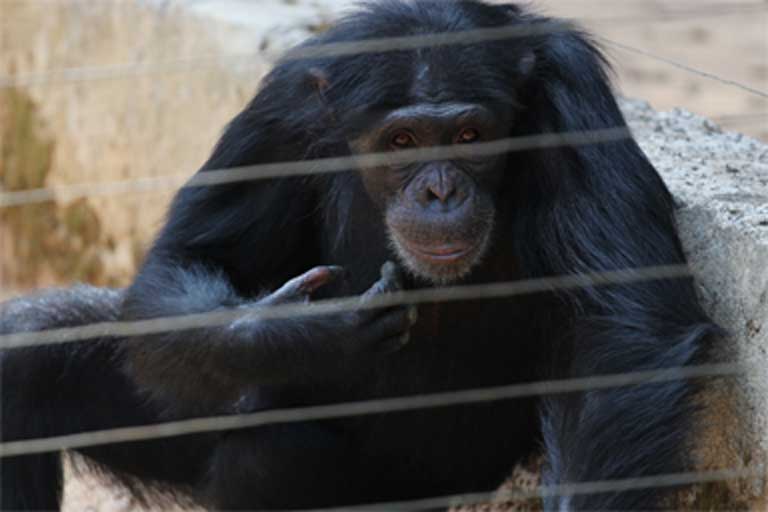
Speede says her organization is also acting on this goal, and is now working with Cameroon’s government to increase protection for chimpanzees and other endangered wildlife still living free.
Part of that strategy, she says, includes better education: her organization has launched an education program in primary schools to create a new generation of Cameroonians who will see great apes proudly as part of the country’s natural heritage, rather than as bushmeat, pets or a natural resource to be hunted and exploited.
“The education program is designed to instill in young people an understanding of chimpanzees as kindred beings, who deserve respect and protection, as well as [instilling] an appreciation of their own roles as future wildlife stewards,” she says.
In the meantime, the fate of Cameroon’s captive chimps hangs in the balance. “We would still love to accomplish reintroduction of some of our rescued chimpanzees, but factors beyond our control would need to change” for that to happen, says Speede.
FEEDBACK: Use this form to send a message to the author of this post. If you want to post a public comment, you can do that at the bottom of the page.






